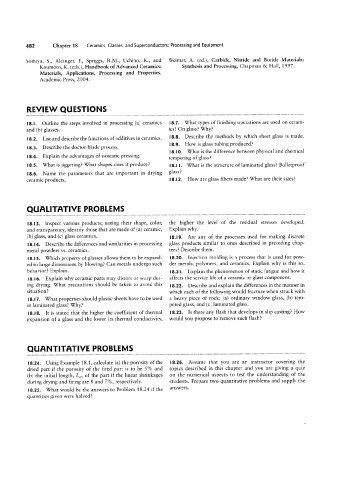Page 502 - 04. Subyek Engineering Materials - Manufacturing, Engineering and Technology SI 6th Edition - Serope Kalpakjian, Stephen Schmid (2009)
P. 502
482 Chapter 18 Ceramics, Glasses, and Superconductors: Processing and Equipment
Somiya, S., Aldinger, F., Spriggs, R.M., Uchino, K., and Weimer, A. (ed.), Carbide, Nitride and Boride Materials:
Koumoto, K. (eds.), Handbook of Advanced Ceramics: Synthesis and Processing, Chapman 86 Hall, 1997.
Materials, Applications, Processing and Properties.
Academic Press, 2004.
REVIEW QUESTIONS
l8.l. Outline the steps involved in processing (a) ceramics |8.7. What types of finishing operations are used on ceram-
and (b) glasses. ics? On glass? Why?
I8.2. List and describe the functions of additives in ceramics. l8.8. Describe the methods by which sheet glass is made.
l8.9. How is glass tubing produced?
I8.3 Describe the doctor-blade process.
l8.|0. What is the difference between physical and chemical
|8.4. Explain the advantages of isostatic pressing. tempering of glass?
I8.S What is jiggering? What shapes does it produce? l8.l I. What is the structure of laminated glass? Bulletproof
I8.6 Name the parameters that are important in drying glass?
ceramic products. l8.I2. How are glass fibers made? What are their sizes?
QUALITATIVE PROBLEMS
l8.l3. Inspect various products; noting their shape, color, the higher the level of the residual stresses developed.
and transparency, identify those that are made of (a) ceramic, Explain why.
(b) glass, and (c) glass ceramics. l8.l9. Are any of the processes used for making discrete
|8.l4. Describe the differences and similarities in processing glass products similar to ones described in preceding chap-
metal powders vs. ceramics. ters? Describe them.
|8.l5. Which property of glasses allows them to be expand- I8.2O. Injection molding is a process that is used for pow-
ed to large dimensions by blowing? Can metals undergo such der metals, polymers, and ceramics. Explain why is this so.
behavior? Explain. l8.2 I. Explain the phenomenon of static fatigue and how it
l8.l 6. Explain why ceramic parts may distort or warp dur- affects the service life of a ceramic or glass component.
ing drying. What precautions should be taken to avoid this l8.22. Describe and explain the differences in the manner in
situation? which each of the following would fracture when struck with
I8. I 7. What properties should plastic sheets have to be used a heavy piece of rock: (a) ordinary window glass, (b) tem-
in laminated glass? Why? pered glass, and (c) laminated glass.
l8.|8. It is stated that the higher the coefficient of thermal l8.23. ls there any flash that develops in slip casting? I-low
expansion of a glass and the lower its thermal conductivity, would you propose to remove such flash?
QUANTITATIVE PROBLEMS
I8.24. Using Example 18.1, calculate (a) the porosity of the l8.26. Assume that you are an instructor covering the
dried part if the porosity of the fired part is to be 5% and topics described in this chapter and you are giving a quiz
(b) the initial length, LO, of the part if the linear shrinkages on the numerical aspects to test the understanding of the
during drying and firing are 8 and 7%, respectively. students. Prepare two quantitative problems and supply the
18.25. What would be the answers to Problem 18.24 if the answers.
quantities given were halved?

